Page 85 of 418
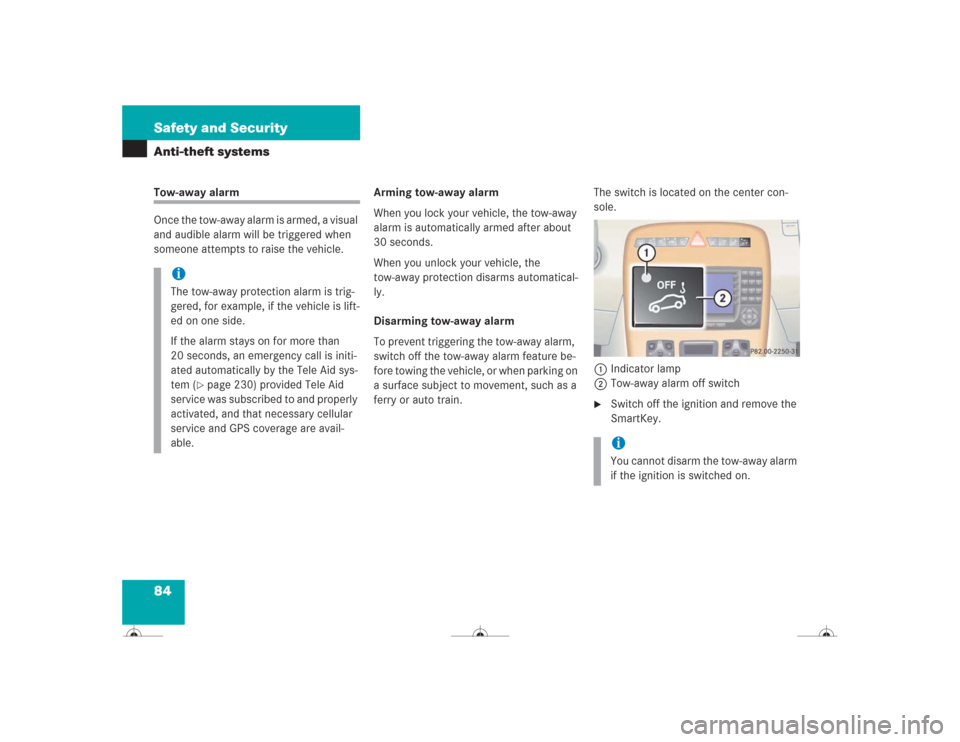
84 Safety and SecurityAnti-theft systemsTow-away alarm
Once the tow-away alarm is armed, a visual
and audible alarm will be triggered when
someone attempts to raise the vehicle.Arming tow-away alarm
When you lock your vehicle, the tow-away
alarm is automatically armed after about
30 seconds.
When you unlock your vehicle, the
tow-away protection disarms automatical-
ly.
Disarming tow-away alarm
To prevent triggering the tow-away alarm,
switch off the tow-away alarm feature be-
fore towing the vehicle, or when parking on
a surface subject to movement, such as a
ferry or auto train.The switch is located on the center con-
sole.
1Indicator lamp
2Tow-away alarm off switch
�
Switch off the ignition and remove the
SmartKey.
iThe tow-away protection alarm is trig-
gered, for example, if the vehicle is lift-
ed on one side.
If the alarm stays on for more than
20 seconds, an emergency call is initi-
ated automatically by the Tele Aid sys-
tem (
�page 230) provided Tele Aid
service was subscribed to and properly
activated, and that necessary cellular
service and GPS coverage are avail-
able.
iYou cannot disarm the tow-away alarm
if the ignition is switched on.
Page 86 of 418
85 Safety and Security
Anti-theft systems
�
Press switch2.
Indicator lamp1 in the switch comes
on briefly.
�
Exit and lock your vehicle with the
SmartKey or (vehicles with
KEYLESS-GO*) the lock button at each
door handle.
The tow-away alarm remains disarmed un-
til you lock your vehicle again.Canceling tow-away alarm
To cancel the alarm:
With the SmartKey
�
Insert the SmartKey in the starter
switch.
or
�
Press the Œ or ‹ button on the
SmartKey.With KEYLESS-GO*
�
Grasp the outside door handle.
or
�
Press the KEYLESS-GO* start/stop
button.
Page 106 of 418
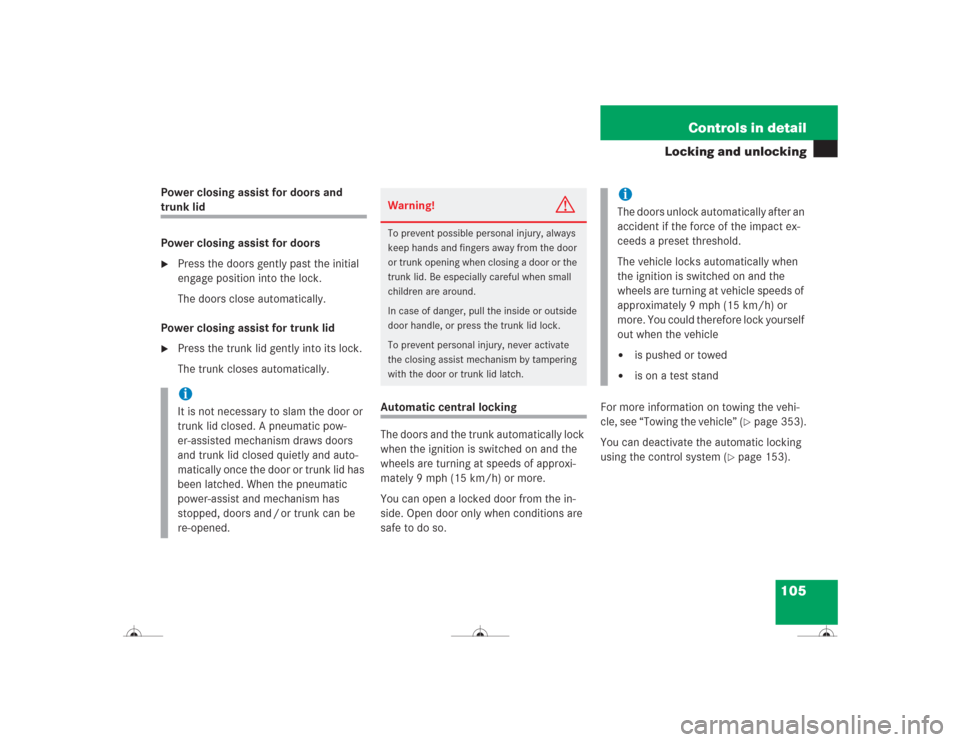
105 Controls in detail
Locking and unlocking
Power closing assist for doors and trunk lid
Power closing assist for doors�
Press the doors gently past the initial
engage position into the lock.
The doors close automatically.
Power closing assist for trunk lid
�
Press the trunk lid gently into its lock.
The trunk closes automatically.
Automatic central locking
The doors and the trunk automatically lock
when the ignition is switched on and the
wheels are turning at speeds of approxi-
mately 9 mph (15 km/h) or more.
You can open a locked door from the in-
side. Open door only when conditions are
safe to do so.For more information on towing the vehi-
cle, see “Towing the vehicle” (
�page 353).
You can deactivate the automatic locking
using the control system (
�page 153).
iIt is not necessary to slam the door or
trunk lid closed. A pneumatic pow-
er-assisted mechanism draws doors
and trunk lid closed quietly and auto-
matically once the door or trunk lid has
been latched. When the pneumatic
power-assist and mechanism has
stopped, doors and / or trunk can be
re-opened.
Warning!
G
To prevent possible personal injury, always
keep hands and fingers away from the door
or trunk opening when closing a door or the
trunk lid. Be especially careful when small
children are around.
In case of danger, pull the inside or outside
door handle, or press the trunk lid lock.
To prevent personal injury, never activate
the closing assist mechanism by tampering
with the door or trunk lid latch.
iThe doors unlock automatically after an
accident if the force of the impact ex-
ceeds a preset threshold.
The vehicle locks automatically when
the ignition is switched on and the
wheels are turning at vehicle speeds of
approximately 9 mph (15 km/h) or
more. You could therefore lock yourself
out when the vehicle�
is pushed or towed
�
is on a test stand
Page 161 of 418
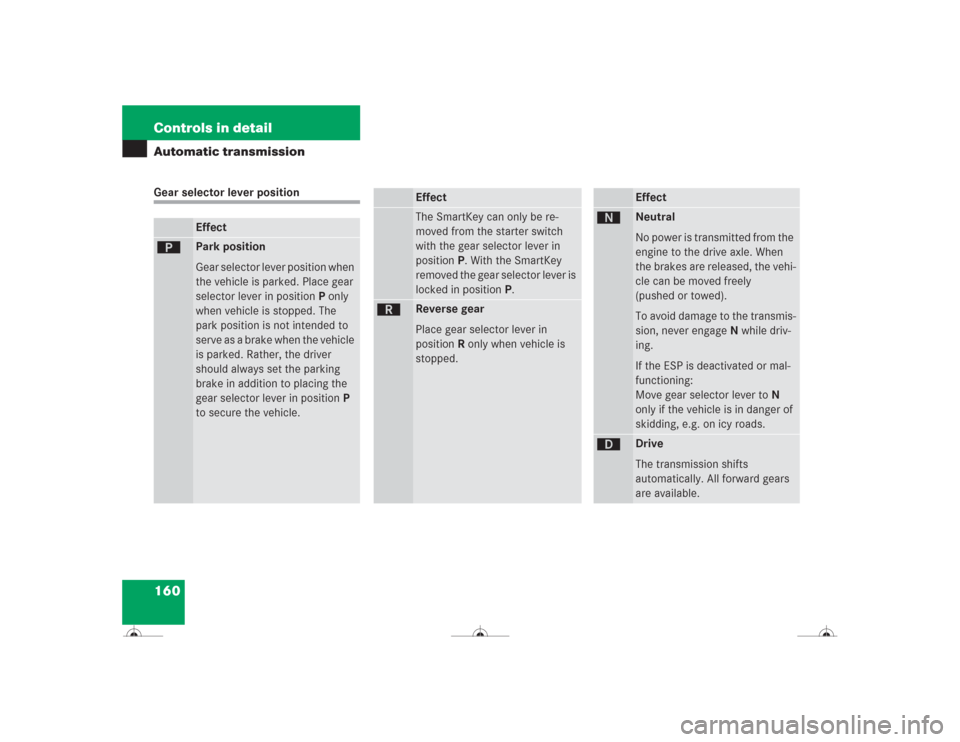
160 Controls in detailAutomatic transmissionGear selector lever position
Effect
ì
Park position
Gear selector lever position when
the vehicle is parked. Place gear
selector lever in positionP only
when vehicle is stopped. The
park position is not intended to
serve as a brake when the vehicle
is parked. Rather, the driver
should always set the parking
brake in addition to placing the
gear selector lever in positionP
to secure the vehicle.
EffectThe SmartKey can only be re-
moved from the starter switch
with the gear selector lever in
positionP. With the SmartKey
removed the gear selector lever is
locked in positionP.
í
Reverse gear
Place gear selector lever in
positionR only when vehicle is
stopped.
Effect
ë
Neutral
No power is transmitted from the
engine to the drive axle. When
the brakes are released, the vehi-
cle can be moved freely
(pushed or towed).
To avoid damage to the transmis-
sion, never engageN while driv-
ing.
If the ESP is deactivated or mal-
functioning:
Move gear selector lever toN
only if the vehicle is in danger of
skidding, e.g. on icy roads.
ê
Drive
The transmission shifts
automatically. All forward gears
are available.
Page 162 of 418
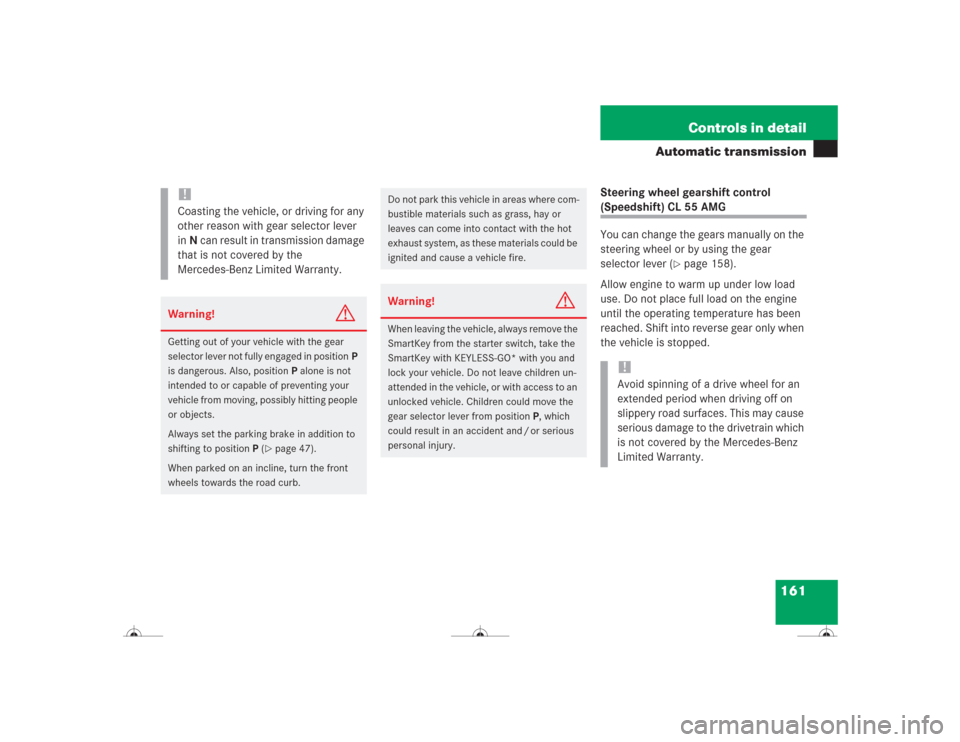
161 Controls in detail
Automatic transmission
Steering wheel gearshift control (Speedshift) CL 55 AMG
You can change the gears manually on the
steering wheel or by using the gear
selector lever (
�page 158).
Allow engine to warm up under low load
use. Do not place full load on the engine
until the operating temperature has been
reached. Shift into reverse gear only when
the vehicle is stopped.
!Coasting the vehicle, or driving for any
other reason with gear selector lever
inN can result in transmission damage
that is not covered by the
Mercedes-Benz Limited Warranty.Warning!
G
Getting out of your vehicle with the gear
selector lever not fully engaged in positionP
is dangerous. Also, positionP alone is not
intended to or capable of preventing your
vehicle from moving, possibly hitting people
or objects.
Always set the parking brake in addition to
shifting to positionP (
�page 47).
When parked on an incline, turn the front
wheels towards the road curb.
Do not park this vehicle in areas where com-
bustible materials such as grass, hay or
leaves can come into contact with the hot
exhaust system, as these materials could be
ignited and cause a vehicle fire.Warning!
G
When leaving the vehicle, always remove the
SmartKey from the starter switch, take the
SmartKey with KEYLESS-GO* with you and
lock your vehicle. Do not leave children un-
attended in the vehicle, or with access to an
unlocked vehicle. Children could move the
gear selector lever from positionP, which
could result in an accident and / or serious
personal injury.
!Avoid spinning of a drive wheel for an
extended period when driving off on
slippery road surfaces. This may cause
serious damage to the drivetrain which
is not covered by the Mercedes-Benz
Limited Warranty.
Page 207 of 418
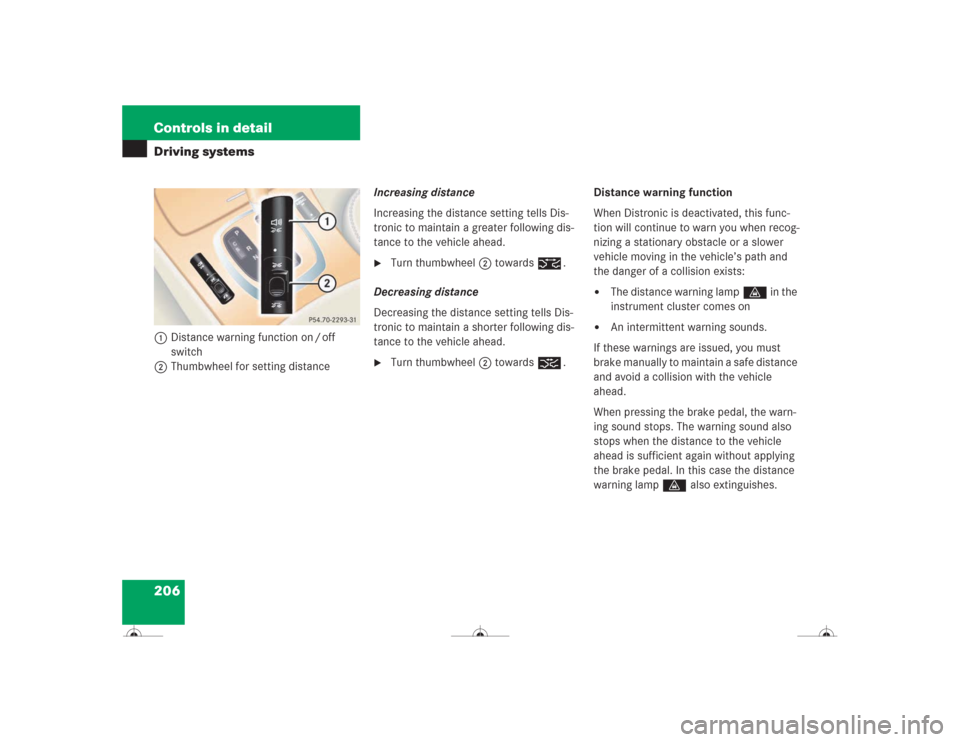
206 Controls in detailDriving systems1Distance warning function on / off
switch
2Thumbwheel for setting distanceIncreasing distance
Increasing the distance setting tells Dis-
tronic to maintain a greater following dis-
tance to the vehicle ahead.
�
Turn thumbwheel2 towards¯.
Decreasing distance
Decreasing the distance setting tells Dis-
tronic to maintain a shorter following dis-
tance to the vehicle ahead.
�
Turn thumbwheel2 towards®.Distance warning function
When Distronic is deactivated, this func-
tion will continue to warn you when recog-
nizing a stationary obstacle or a slower
vehicle moving in the vehicle’s path and
the danger of a collision exists:
�
The distance warning lampl in the
instrument cluster comes on
�
An intermittent warning sounds.
If these warnings are issued, you must
brake manually to maintain a safe distance
and avoid a collision with the vehicle
ahead.
When pressing the brake pedal, the warn-
ing sound stops. The warning sound also
stops when the distance to the vehicle
ahead is sufficient again without applying
the brake pedal. In this case the distance
warning lampl also extinguishes.
Page 222 of 418
221 Controls in detail
Useful features
�Useful features
Storage compartments Glove box
1Unlocked
2Locked
3Glove box lid release
Locking the glove box
�
Insert the mechanical key
(�page 331) into the glove box lock.
�
Turn the mechanical key to
position2.Unlocking the glove box
�
Insert the mechanical key
(�page 331) into the glove box lock.
�
Turn the mechanical key to
position1.
Opening the glove box
�
Press button3.
The glove box lid opens downward.
Closing the glove box
�
Push lid up to close.
Warning!
G
To help avoid personal injury during a colli-
sion or sudden maneuver, exercise care
when stowing objects in the vehicle. Put lug-
gage or cargo in the trunk if possible. Do not
pile luggage or cargo higher than the seat
backs.
Luggage nets cannot secure hard or heavy
objects.
Keep compartment lids closed. This will help
to prevent stored objects from being thrown
about and injuring vehicle occupants during
an accident.
Page 233 of 418
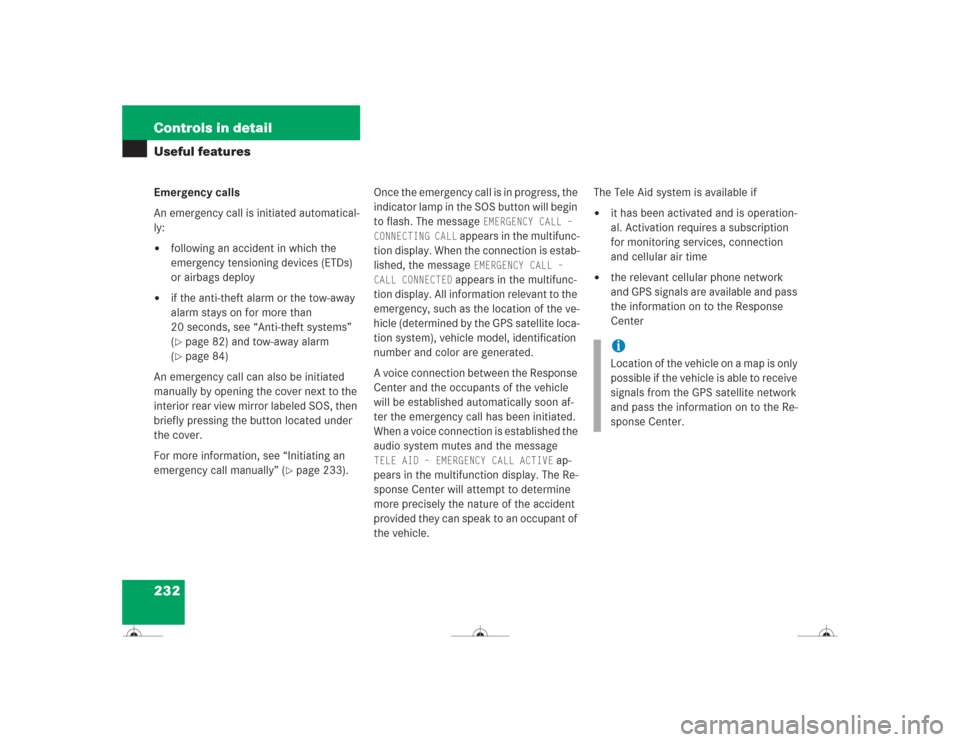
232 Controls in detailUseful featuresEmergency calls
An emergency call is initiated automatical-
ly:�
following an accident in which the
emergency tensioning devices (ETDs)
or airbags deploy
�
if the anti-theft alarm or the tow-away
alarm stays on for more than
20 seconds, see “Anti-theft systems”
(�page 82) and tow-away alarm
(�page 84)
An emergency call can also be initiated
manually by opening the cover next to the
interior rear view mirror labeled SOS, then
briefly pressing the button located under
the cover.
For more information, see “Initiating an
emergency call manually” (
�page 233).Once the emergency call is in progress, the
indicator lamp in the SOS button will begin
to flash. The message
EMERGENCY CALL –
CONNECTING CALL
appears in the multifunc-
tion display. When the connection is estab-
lished, the message
EMERGENCY CALL –
CALL CONNECTED
appears in the multifunc-
tion display. All information relevant to the
emergency, such as the location of the ve-
hicle (determined by the GPS satellite loca-
tion system), vehicle model, identification
number and color are generated.
A voice connection between the Response
Center and the occupants of the vehicle
will be established automatically soon af-
ter the emergency call has been initiated.
When a voice connection is established the
audio system mutes and the message
TELE AID – EMERGENCY CALL ACTIVE
ap-
pears in the multifunction display. The Re-
sponse Center will attempt to determine
more precisely the nature of the accident
provided they can speak to an occupant of
the vehicle.The Tele Aid system is available if
�
it has been activated and is operation-
al. Activation requires a subscription
for monitoring services, connection
and cellular air time
�
the relevant cellular phone network
and GPS signals are available and pass
the information on to the Response
CenteriLocation of the vehicle on a map is only
possible if the vehicle is able to receive
signals from the GPS satellite network
and pass the information on to the Re-
sponse Center.